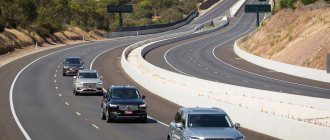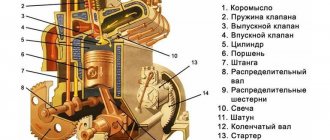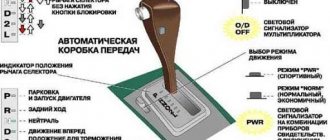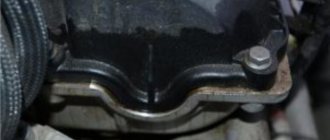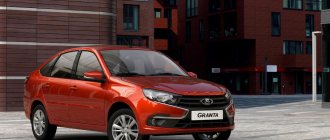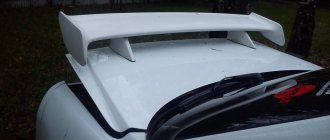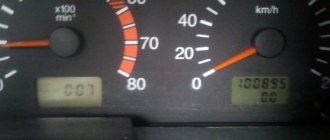What is distance in traffic rules: definition
According to traffic regulations, it is customary to call the driving distance from one car to another a distance without risk. As a rule, in modern road conditions there is always a car in front, and the risk of an accident is excluded only in one case: a gap must be provided before it that is sufficient for braking. Most collisions occur precisely because of the short braking distance between cars. The driver does not have time to orient himself when the front participant brakes sharply. In more severe cases, this leads to a chain reaction and several cars crash in a row, for example, in winter or in the rain.
Thus, the concept of “distance” is relevant for motorists moving after other participants along the same trajectory. However, equally important is determining the speed of movement.
- According to traffic regulations, when determining the shortest distance between cars when driving, the speed of the vehicle is taken as a fundamental criterion. This value is divided by 2, and the most optimal distance is displayed.
- Any experienced driver automatically slows down when approaching cars in front.
- Insurance agents recommend defining safe footage as two-thirds of the length of the car body.
Distance between cars according to traffic rules: ensuring safety
What distance should be between cars according to traffic rules in meters? When a driver moves closely behind another car, he is deprived of some freedom of action, for example:
- It is impossible to drive around a car that has suddenly stopped. Reversing is not always possible because there are other cars behind you;
- insufficient view of the road;
- it is impossible to brake urgently because there is no room for a stopping distance;
- fail to accelerate and fail to perform most maneuvers.
When driving behind a car, it is recommended to keep a distance that allows you to stop the car, make a maneuver and avoid a collision. Let’s assume that the distance between cars is equal to the speed of the vehicle.
Minimum On dry asphalt or a good road after rain, the safe distance between moving cars is 2 seconds or 3 meters.
Safe distance between cars according to traffic rules in meters
The distance, as well as the speed, is set by the driver himself. First of all, he should be guided by his driving experience, the characteristics of the car model and weather conditions. Traffic regulations include clauses according to which the distance between cars varies taking into account the actual road situation. It is customary to distinguish between the minimum allowable interval, the permitted interval on the highway and in the city, as well as other types of distances.
Minimum
The most optimal distance between cars according to traffic regulations is three meters. But this is only under ideal conditions. If it is raining, the gap between vehicles must be increased by at least 4 times, in snow - by 3 times.
More information about road quality and weather conditions:
- dry asphalt, no precipitation - 3 m (2 sec);
- poor-quality, wet or clayey coating - 4 meters (3-4 sec);
- precipitation in the form of snow or rain, ice - 6 meters (5 sec).
Drivers without proper driving experience are advised to maintain a minimum distance of 8 meters or 7 seconds.
In the city
In the city, the pace of movement is much higher than on the highways. Acceleration, constant speed, and braking alternate here. Therefore, it is very difficult to maintain a safe distance. Even experienced motorists who have been behind the wheel for at least 7-8 years find it difficult to get used to this mode.
The recommended average distance in the city is 3 meters. Beginners are advised to maintain at least five meters. It’s generally difficult for them, they try not to get closer than 5-10 meters to the front car, but thereby create problems. An experienced driver drives into the resulting gap, and the distance between the cars is sharply reduced. All this must be taken into account, act according to the specific situation, not forgetting about the law.
On a country road
Everything depends on the quality of the asphalt.
Here are the points regarding the distance between cars on the highway that are stated in the traffic rules:
- if there are no special obstacles on the route, contaminated or blocked sections of the track due to repairs, you must maintain at least three meters from the front car;
- if there are holes, fallen tree branches, other small obstacles, or if the car is driven at night, the distance must be increased to four meters;
- if the road is frozen and covered with powder, then in the daytime - six meters, at night - 7 meters;
- on ice, surfaces with a thin film of water, during snowfalls with partial thawing - seven meters.
In a traffic jam
In traffic jams, the distance between cars according to traffic rules should be half the length of the car, which is the same as 2 meters. This gap is quite enough to change lanes without creating an emergency situation. Everything needs to be taken into account, for example, if the car in front suddenly stalls.
On difficult roads, in conditions of poor visibility, on narrow streets and closed turns, the gap should be maintained so that the braking distance of the vehicle is less than the visibility distance.
When stopping
When stopping the car, you must also maintain a distance, depending on the weather conditions and the quality of the road. On icy roads and snow, you need to maintain a gap of 4 seconds.
The car often stops at traffic lights, and here it is important to maintain the correct distance to prevent an accident. It is not recommended to approach the front car less than 2-3 meters.
In the parking lot
This point is not clearly stated in the traffic rules. The fact is that the length to a parked car here depends on specific conditions. When parking, you should allow enough space in front to be able to get out in case another car stops behind you.
For truck
It is extremely important for a truck driver to control the situation in front of a passenger car! On the highways, it is recommended to maintain the safest gap of 40-80 meters. This will be enough to stop the car without the risk of a collision.
Up to a large vehicle
Large cargo transport vehicles or large buses block the view of drivers moving behind. And the more massive they are, the greater the distance to them should be. On the highways, many people try to overtake trucks, but it is important to maintain a 10-meter gap.
Lateral spacing
This gap is no less important for road safety. The lateral interval according to traffic rules is the distance on the side between cars. When overtaking, on wide highways with several lanes, the cars end up on the same horizontal plane. It is noteworthy that the largest number of accidents occurs due to improperly maintained side clearance. The rules state that this distance must be calculated taking into account:
- technical condition and serviceability of the machine;
- pace of movement;
- other influencing factors, including even the driver’s well-being.
Allowable distance between cars
Heavy vehicle traffic leads to the following:
- there is no way to overtake a car that suddenly decides to stop. At the same time, handing over is also not feasible, since the car is supported by others;
- no good view of the road;
- there is not enough space to perform emergency braking;
- most maneuvers are impossible.
We invite you to read: Court of Appeal in a criminal case
Therefore, the distance between cars according to traffic rules in meters allows you to make the necessary stop or maneuver, avoiding a collision with another vehicle. In different situations, special distance conditions must apply.
Most often, accidents occur within the city. The fact is that in urban conditions the recommended distance is difficult to maintain due to traffic jams and the need to quickly change lanes.
Novice drivers usually try to keep a distance of more than 5 m, which is a mistake. Thus, a large distance between cars in the city can also lead to emergency situations. Experts recommend keeping a distance of about two-thirds of the vehicle's length, usually 3-4 m. Experienced drivers can reduce this figure to 2 m, as they have a faster reaction.
A high speed limit is allowed on the highway, this in turn causes an increase in the distance between cars. The distance is determined by the condition of the road, so in order to overcome the distance to the car in front, drivers must have:
- 2 seconds – in the absence of obstacles on the road, pollution, or repairs;
- 3 seconds – when driving on a high-quality road surface at night, or after precipitation, in the presence of minor obstacles, fallen branches, small holes that can be easily avoided;
- 4 seconds – when there is snow and frost on the road surface, and movement is carried out during the day;
- 5 seconds – while driving on a snowy road at night, in the presence of ice or densely packed snow;
- 6 seconds - in case of ice, snowy roads, the presence of a thin film of water, after wet snow.
At the traffic light
The traffic rules clearly state that every driver must maintain a distance to avoid an emergency. So, a car standing at a traffic light and waiting for a permit sign should not be pressed against another car. Here it is necessary to maintain such a distance so that there is no need to use reverse gear when going around a neighboring car if it has stalled.
When stopping at a crowded intersection, the driver must maintain a distance of 2-3 meters. This is necessary so that if a car collides, it does not hit the others. Thus, leaving a few meters, if necessary, you can easily change lanes to another lane.
As part of the column
An organized convoy of vehicles must follow special rules while driving. So, all maneuvers are performed in coordination, they must have the same speed. Based on paragraph 9.11 of the traffic rules, the convoy must not leave a distance between cars that allows other moving cars to overtake it.
According to theory, the distance is calculated at 1 m per 1 km/h, to ensure safety during sudden braking. But observing this, the column of cars will stretch over a long distance, which will create many problems for other vehicles. Therefore, experts still advise, when choosing a distance, to pay attention to the body size of the longest car in the column and the speed limit:
- Up to 40 km/h – 8 m;
- 40-60 km/h when driving in the city - about 12 m;
- 60-80 km/h on the highway – 15 m;
- More than 80 km/h – about 25 m.
We recommend: Transportation of oversized cargo
We invite you to familiarize yourself with: The procedure for registering a deed of gift for a personal car
In a traffic jam
The normal distance is half the vehicle. Beginners are advised to keep 2-3 car lengths in traffic. This, in turn, is about 2 m. With this distance, it is easy to change to another lane if the car in front breaks down.
The distance between vehicles moving in the same direction is the distance at which a collision can be avoided.
It would seem that the regulations of the traffic rules should state the permissible interval, but no - the traffic rules do not contain information about such a gap, fixed in meters. In this case, the car owner should be guided by the specific situation and determine the size of the distance independently.
The main rule that you need to rely on when choosing the distance between cars is paragraph 9.10 of the traffic rules, which states that the distance to the vehicle moving ahead should allow you to avoid a collision in the event of a dangerous situation.
In other words, when choosing a gap, the car owner must anticipate the possibility of sudden braking, both for his own and for the car in front. In this case, you should also pay attention to the traffic moving behind. Similarly, it is necessary to determine the lateral interval.
The choice of distance depends on a number of conditions:
- movement speed - the higher it is, the longer the gap;
- transport characteristics;
- time of day - at night the interval should be increased;
- weather conditions, for example, ice, require adding several meters to the observed interval;
- road condition and other issues.
The recommended distance between vehicles in urban areas is 3-4 m at a speed of less than 60 km/h. When accelerating to 80 km/h on the highway, the gap should be 15-20 m.
Another rule that somewhat regulates distance requirements is paragraph 9.11 of the Traffic Regulations, which warns that if a vehicle is moving slower than cars in the main stream, its driver must provide overtaking vehicles with a distance that is optimal for changing lanes and overtaking.
Most often, the issue of determining a safe distance is touched upon during driving training, or rather, during practical lessons. The driving instructor is obliged to tell the beginner how, without being distracted from the movement, to determine the interval between his own vehicle and the one moving ahead.
Sign "Minimum distance limit"
This is a warning sign. It prohibits the movement of cars if the gap between them is less than indicated on the board. As a rule, it is installed on difficult sections of the route, where there are bridges, tunnels, ice crossings, utilities, and pontoons. The traffic rules are stated as 3.16.
The sign is valid up to the nearest intersection, beginning or end of a populated area. There may also be a 3.31 sign meaning "End of all restrictions area".
Installing this sign solves two important problems:
- facilitates control over the order of automobile traffic, the degree of danger of a particular car from a moving convoy is adequately assessed;
- the density of traffic flow is reduced on difficult sections of roads associated with traffic on spans.
You can meet this sign, for example, in front of customs. It will not be possible to overtake other traffic participants here: a kind of waiting area is formed. Any attempt to maneuver will lead to a major accident in which several cars will suffer.
Amount of fines for non-compliance with distance
A fine of 1,500 rubles for failure to maintain the distance is issued by law only after an accident occurs. Often such incidents occur in large cities where there is a lot of congestion. Non-compliance is noted on two points - incorrect speed and distance.
This penalty does not apply to an accident where one of the vehicles is parked or not moving.
Remember that rules do not provide a clear picture of what to do. The driver should always rely on himself, drive carefully, and not take traffic rules literally. For example, it is simply impossible to distance yourself by five meters in city traffic, otherwise a traffic jam will form. And the traffic rules themselves indicate that you must move at the speed of traffic flow.
Table: excerpts from traffic rules
| Clause 9.10. | The driver must maintain such a distance from the vehicle in front that would allow him to avoid a collision, as well as the necessary lateral interval to ensure traffic safety. |
| Clause 9.11. | Outside populated areas on two-way roads with two lanes, the driver of a vehicle for which a speed limit is set, as well as the driver of a vehicle (vehicle combination) longer than 7 m, must maintain such a distance between his and the vehicle moving ahead, so that overtaking vehicles can move into the lane they previously occupied without interference. This requirement does not apply when driving on sections of roads where overtaking is prohibited, as well as during heavy traffic and movement in an organized transport convoy. |
| Clause 10.1. | If a traffic hazard arises that the driver is able to detect, he must take all possible measures to reduce speed, including stopping the vehicle. |
| Clause 10.5. | The driver is prohibited from suddenly braking unless it is necessary to prevent a traffic accident. |
Table: effective speed on tracks under different circumstances
| Effective value | Description | Add-ons |
| 2 seconds | Good weather, clear, dry asphalt. | No obstacles, no repair areas, no dirt. |
| 3 seconds | The track has a clay surface. | Driving in the dark, on a clear day with some obstacles (branches, holes) that are easy to pass). |
| 4 seconds | The road is wet, it snowed recently | Frost, snow during daylight hours. |
| 5 second | There is snow on the road, it is dark. | Danger of ice, wet snow. |
| 5 second | The road is covered with snow. | The snow is packed. |
| 6 seconds | The road is heavily snowed. | A thin film of water is visible. |
| 7 seconds | Effective distance designed for beginners | Applies to drivers who have recently mastered traffic rules (without practical experience). |
If you have any questions, leave them in the comments below the article. We or our visitors will be happy to answer them
What distance should be between vehicles?
The distance between cars according to traffic rules must be strictly observed by drivers. However, situations often arise when a driver moves in traffic closely behind another car and is deprived of freedom of action, for example:
- it is impossible to brake urgently, since there is no room for a stopping distance;
- You cannot drive around a vehicle that has suddenly stopped. It is also impossible to reverse because of the cars standing behind;
- fail to accelerate or complete most maneuvers;
- insufficient view of the road.
When driving behind a car, it is recommended to keep a distance that allows you to stop, make a maneuver and avoid a collision.
Minimum
On dry asphalt, the minimum distance between moving vehicles is 3 meters (2 seconds). If the road surface is of poor quality, wet, or there is clay on the route, then this distance increases to the equivalent of 3-4 seconds.
If there is various precipitation: wet snow, rain, ice on the road, the safest distance is 5-6 seconds. Drivers who do not have much skill are advised to maintain a minimum distance of at least 7-8 seconds.
If snow has fallen, but it is sufficiently compacted, then experienced drivers can keep a distance of 4 seconds, beginners - 5 seconds.
In the city
In the city, an experienced driver will take advantage of this distance and will force a beginner to shorten the distance and become nervous. On average, the recommended safe distance between cars in urban traffic is 3 meters. This is approximately 2/3 of the length of the car body.
For novice drivers, you need to keep a distance of at least 5 meters.
On the tracks
The distance on the routes directly depends on the condition of the road surface. The distance to the next car should be:
- 2 seconds if the asphalt road does not contain any obstacles in the form of contaminated areas or repair work;
- 3 seconds, when there are small obstacles on the road (potholes, fallen branches) that can be easily avoided;
- 3 seconds if driving on a high-quality road surface, but in the dark;
- 4 seconds – during daylight hours, when the road is covered with frost and snow;
- 5 seconds if the driver is driving at night on a snowy road;
- 6 seconds, when there is ice on the road, wet snow has passed, the road is snowy, and a thin film of water has formed on the road surface.
In a traffic jam
The normal distance between cars is equal to half a car. For beginners, it is 2/3 of the length of the car, which is, on average, 2 meters. This distance is quite enough to change lanes without creating an emergency if the car in front suddenly stalls. This will reduce the risk of sudden maneuvers from other cars.
We recommend: Category “E” – which means how to get it, fines for absence
On difficult sections of the road or in bad weather, the distance should be such that the braking distance of the car is less than the visibility distance. This rule applies to driving at intersections with poor visibility, on narrow streets, and in closed turns.
At the traffic light
The traffic rules state that the driver must maintain a distance that will prevent an emergency situation from occurring. At a traffic light, it is not recommended to get too close to the car in front to avoid an accident.
When stopping in front of a busy intersection, the distance should be 2-3 meters so that in the event of an impact the car does not hit other vehicles. By leaving a distance of several meters to the next car, there is a chance to avoid an accident when changing lanes.
In the parking lot
The parking distance depends solely on the specific situation; this distance is not clearly defined in the traffic rules. So, it should be such that the driver and passengers can freely get out of the car. If the driver has stopped behind a parked car, then it is necessary to leave space in order to get out freely if another car gets behind him.
When stopping
When stopping, movement directly depends on the quality of the road surface:
- on dirty and wet asphalt the distance is 3 seconds;
- on a road with obstacles or on an icy road equals 5 seconds;
- on a winter road the distance is 4 seconds.
The driver must immediately increase the distance if there is a sudden malfunction in the car's operation, the oncoming vehicle has turned on its high beams, or the tires are worn out of season.
